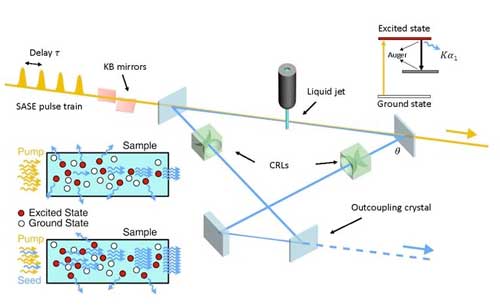| Jan 20, 2021 |
A sharp new eye to view atoms and molecules
(Nanowerk News) Since the 1960s, physicists have dreamed of producing X-ray laser pulses that probe matter at the level of atoms and molecules. This requires tools that work at ultrashort and ultrafast space and time scales.
|
|
Scientists realized this dream in 2009 with the world’s first hard X-ray free-electron laser, the Linac Coherent Light Source (LCLS). But each LCLS X-ray pulse has a slightly different intensity and wavelength distribution, a challenge for experiments.
|
|
A new oscillator design overcomes these problems with an approach inspired by optical lasers (PNAS, "Population inversion X-ray laser oscillator").
|
|
Like an optical laser, the oscillator generates stable, high-power pulses at a well-defined X-ray wavelength that can be varied over a large interval. The X-ray pulse duration is very short, about the same as atomic-molecular processes, and the wavelength is about the atomic size or smaller.
|
|
These characteristics open novel avenues for experiments in biology, chemistry, materials science, and physics.
|
 |
| X-ray pulses focused on a liquid jet excite electrons. When the electrons lose energy, a flux of X-rays is released. The original pulse plus the new flux of photons then recirculate, further amplifying the X-rays that can be directed to experiments. (Image: SLAC National Accelerator Laboratory) (click on image to enlarge)
|
|
The new X-ray laser oscillator generates types of pulses that were never before possible. The pulses are stable, intense, and of ultrashort duration and have a well-defined wavelength. This ability opens new possibilities in experiments and research. These applications include quantum optics and chemical dynamics. Other areas include imaging, spectroscopy, and interferometry.
|
|
Laser physicists have dreamed since the 1960s of an oscillator generating X-ray laser pulses at Ångström wavelength and femtosecond time duration, the characteristic length and time scale of atomic and molecular phenomena.
|
|
This recent research provides the basis to make this dream become reality. It describes an X-ray oscillator using LCLS to push electrons in a metal compound to an excited energy state, from which they decay to a lower energy state generating a large flux of X-rays at a well-defined wavelength and direction. The metal compound is placed inside a cavity made of diamond crystal mirrors to recirculate the X-rays.
|
|
After completing the first loop, the X-rays join up with a second LCLS pulse producing an even brighter laser pulse, which then takes the same loop. The process is repeated several times, and the laser pulse intensifies with each loop. During the last loop, one of the mirrors is quickly switched, allowing the high intensity pulse to exit.
|
|
Once it exits the oscillator, the pulse can be used for experiments in areas including quantum optics, chemical dynamics, imaging, spectroscopy, and interferometric measurements.
|

